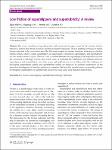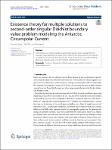Search
Author
- Osman, Ahmed I. (5)
- Daqing, Ma (3)
- Jorgensen, Ed (3)
- Li, Yan (3)
- next >
Subject
- kinh tế (26)
- Economics (12)
- programming (10)
- XRD (10)
- next >
Date issued
- 2020 - 2025 (2128)
- 2010 - 2019 (129)
- 2000 - 2009 (9)
- 1999 - 1999 (1)
Has File(s)
Search Results
This book is meant to be a second course in fluid mechanics that stresses applications dealing with external potential flows and intermediate viscous flows. Students are expected to have some background in some of the fundamental concepts of the definition of a fluid, hydrostatics, use of control volume conservation principles, initial exposure to the Navier-Stokes equations, and some elements of flow kinematics, such as streamlines and vorticity. It is not meant to be an in-depth study of potential flow or viscous flow, but is meant to expose students to additional analysis techniques for both of these categories of flows. We will see applications to aerodynamics, with analysis methods able to determine forces on arbitrary bodies. We will also examine some of the exact solutions of... |
Given a set of agents with approval preferences over each other, we study the task of finding k matchings fairly representing everyone’s preferences. To formalize fairness, we apply the concept of proportional representation as studied in approval-based multiwinner elections. To this end, we model the problem as a multiwinner election where the set of candidates consists of matchings of the agents, and agents’ preferences over each other are lifted to preferences over matchings. Due to the exponential number of candidates in such elections, standard algorithms for classical sequential voting rules (such as those proposed by Thiele and Phragmén) are rendered inefficient. |
The overarching aim of this open access book is to present self-contained theory and algorithms for investigation and prediction of electric demand peaks. A cross-section of popular demand forecasting algorithms from statistics, machine learning and mathematics is presented, followed by extreme value theory techniques with examples. In order to achieve carbon targets, good forecasts of peaks are essential. For instance, shifting demand or charging battery depends on correct demand predictions in time. Majority of forecasting algorithms historically were focused on average load prediction. In order to model the peaks, methods from extreme value theory are applied. This allows us to study extremes without making any assumption on the central parts of demand distribution and to predict... |
We study singular perturbations of eigenvalues of the polyharmonic operator on bounded domains under removal of small interior compact sets. We consider both homogeneous Dirichlet and Navier conditions on the external boundary, while we impose homogeneous Dirichlet conditions on the boundary of the removed set. To this aim, we develop a notion of capacity which is suitable for our higher-order context, and which permits to obtain a description of the asymptotic behaviour of perturbed simple eigenvalues in terms of a capacity of the removed set, in dependence of the respective normalized eigenfunction. |
The paper investigates stability properties of solutions of optimal control problems constrained by semilinear parabolic partial differential equations. Hölder or Lipschitz dependence of the optimal solution on perturbations are obtained for problems in which the equation and the objective functional are affine with respect to the control. The perturbations may appear in both the equation and in the objective functional and may nonlinearly depend on the state and control variables. |
Given input–output pairs of an elliptic partial differential equation (PDE) in three dimensions, we derive the first theoretically rigorous scheme for learning the associated Green’s function G. By exploiting the hierarchical low-rank structure of G, we show that one can construct an approximant to G that converges almost surely and achieves a relative error of O(Γ−1/2ϵlog3(1/ϵ)ϵ) using at most O(ϵ−6log4(1/ϵ)) input–output training pairs with high probability, for any 0<ϵ<1. The quantity 0<Γϵ≤1 characterizes the quality of the training dataset. Along the way, we extend the randomized singular value decomposition algorithm for learning matrices to Hilbert–Schmidt operators and characterize the quality of covariance kernels for PDE learning. |
The issues regarding energy dissipation and component damage caused by the interface friction between a friction pair attract enormous attention to friction reduction. The key-enabling technique to realize friction reduction is the use of lubricants. The lubricants smooth the contact interfaces, achieving an ultralow friction contact, which is called superslippery or superlubricity. At present, superslippery and superlubricity are two isolated research topics. There is a lack of unified definition on superslippery and superlubricity from the viewpoint of tribology. Herein, this review aims at exploring the differences and relations between superslippery and superlubricity from their origin and application scenarios. Meanwhile, the challenges for developing superslippery surface and ... |
Lung cancer (LC) is the most common solid tumor type in the intensive care unit (ICU). This study investigated the characteristics of LC patients admitted to the ICU, the major reasons for their admission, short-term mortality, and associated risk factors. |
In the article, we present multiple solutions for a second-order singular Dirichlet boundary value problem that arises when modeling the ocean flow of the Antarctic Circumpolar Current. The main tools of the proof are the Leray–Schauder nonlinear alternative principle and a well-known fixed point theorem in cones. |
In this paper, blow-up solutions of autonomous ordinary differential equations (ODEs) which are unstable under perturbations of initial points, referred to as saddle-type blow-up solutions, are studied. Combining dynamical systems machinery (e.g., compactifications, timescale desingularizations of vector fields) with tools from computer-assisted proofs (e.g., rigorous integrators, the parameterization method for invariant manifolds), these blow-up solutions are obtained as trajectories on local stable manifolds of hyperbolic saddle equilibria at infinity. With the help of computer-assisted proofs, global trajectories on stable manifolds, inducing blow-up solutions, provide a global picture organized by global-in-time solutions and blow-up solutions simultaneously. |










